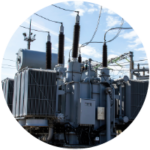Welcome to Powerprojects India
POWER SYSTEM STUDIES & ANALYSIS FOR
Renewables, Offshore Oil & Gas, Data Centres, Manufacturing & Process, Transmission & Distribution, Water & Wastewater
Power Projects global team is one of the largest and most experienced teams of power system engineers in the industry, with industry-standard
software and advanced modeling and analysis capabilities at their fingertips.

About Us
Power Projects provides power system consulting services to power utilities and industries in Indian & global markets. We offer solutions and recommendations from small-scale industrial system to highly complex national grid level networks. Power Projects established in the year of 2006, We are committed to exceed the expectations of clients by providing cost effective, innovative solutions without compromising the quality of service that we offer. Our skills include every aspects of electrical engineering needs like, Power System studies consulting services, Detailed engineering, Design engineering, & Technical Support. Largest and most experienced teams of power system engineers in the industry, with industry standard software & advanced modeling and analysis capabilities at their fingertips.









